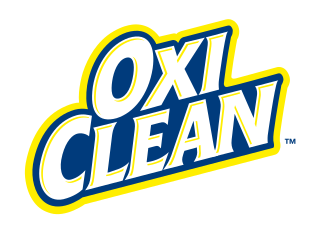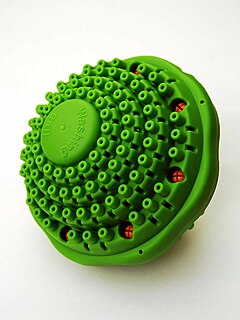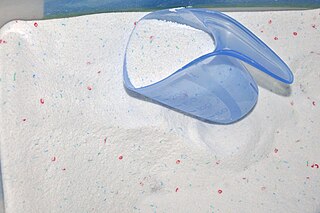This page is based on this
Wikipedia article Text is available under the
CC BY-SA 4.0 license; additional terms may apply.
Images, videos and audio are available under their respective licenses.

Tide is a laundry detergent owned and produced by American multinational Procter & Gamble. Introduced in 1946, it is the highest selling detergent brand in the world, with an estimated 14.3 percent of the global market.

Persil is a brand of laundry detergent manufactured and marketed by Henkel around the world except in the United Kingdom, Ireland, France, Latin America, China, Australia and New Zealand, where it is manufactured and marketed by Unilever. Persil was introduced in 1907 by Henkel. It was the first commercially available "self-activated" laundry detergent. The name was derived from two of its original ingredients, sodium perborate and sodium silicate.

OxiClean is a line of household cleaners, including OxiClean Versatile Stain Remover, which is a laundry additive, spot stain remover, and household cleaner marketed by Church & Dwight. It was owned by Orange Glo International until 2006.

Dreft is a laundry detergent in the United States, Canada, United Kingdom and other markets. First produced by Procter & Gamble in 1933, it was the first synthetic detergent made. The Fairy brand of washing-up liquid and Cascade brand of dishwashing detergent are also sold under the name "Dreft" in some countries, including the Netherlands and Belgium. In Canada, it is called Ivory Snow.

Wet cleaning refers to methods of professional cleaning that, in contrast to traditional dry cleaning, avoids the use of chemical solvents, the most common of which is tetrachloroethylene. Environmental groups and the United States Environmental Protection Agency have indicated that such alternative "wet cleaning" methods are better for the environment than perc, and proponents of wet cleaning state that these methods can be used without shrinking or otherwise damaging garments that typically require dry cleaning.

Ajax is a brand of household cleaning products made by Colgate-Palmolive. The brand is also licensed by Colgate-Palmolive to Phoenix Brands LLC since 2005 for laundry detergents in the United States, Canada and Puerto Rico.

Tetraacetylethylenediamine, commonly abbreviated as TAED, is an organic compound with the formula (CH3C(O))2NCH2CH2N(C(O)CH3)2. This white solid is commonly used as a bleach activator in laundry detergents and for paper pulp. It is produced by acetylation of ethylenediamine.

A laundry ball or washing ball is a product promoted as a substitute for laundry detergent. Producers of laundry balls often make pseudoscientific claims about how these balls work and exaggerate the extent of their benefits.
Cheer is a laundry detergent sold in the United States and Canada. It is manufactured by Procter & Gamble.
Wisk was a brand of laundry detergent manufactured in the United States by Unilever and Sun Products.
Woolite is a brand of laundry detergent owned by British multinational Reckitt Benckiser. The company acquired the Woolite brand when it bought Boyle-Midway from American Home Products / Wyeth in 1990. The company manufactures laundry accessories, among other consumer goods.
Environmental impacts of cleaning agents are the consequences of chemical compounds in cleaning products. Cleaning agents can be bioactive with consequences ranging from mild to severe. Developmental and endocrine disruptors have been linked to cleaning agents. Green cleaning is an approach to redress or address the problems associated with traditional cleaning agents.
Phosphates in detergent refers to the use of phosphates as an ingredient in a detergent product. The advantage of using phosphates in a consumer laundry detergent or dishwashing detergent is that they make detergents more efficient by chelating calcium and magnesium ions. The disadvantage of using phosphates is that they remain in wastewater and eventually make their way to a natural body of water. While phosphates are low toxicity, they instead cause nutrient pollution and feed the algae. This leads to eutrophication and harmful algal bloom.

Tide Pods are a line of laundry detergent pods from Procter & Gamble's Tide brand, which can be deadly if ingested, and which have been labelled as a health risk by the Centers for Disease Control and Prevention. There have been numerous media reports discussing how children and those with dementia could endanger their health or life by consuming the pods, mistaking them for sweets. Between 2012 and 2013, poison control centers reported over 7,000 cases of young children eating laundry pods, and ingestion of Procter & Gamble laundry pods had resulted in six deaths by 2017. In response to the dangers, Procter & Gamble changed Tide Pod containers to an opaque design, introduced warning labels and added a bitter tasting chemical to the pod contents.










